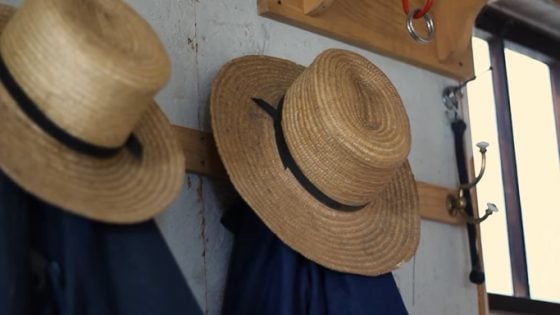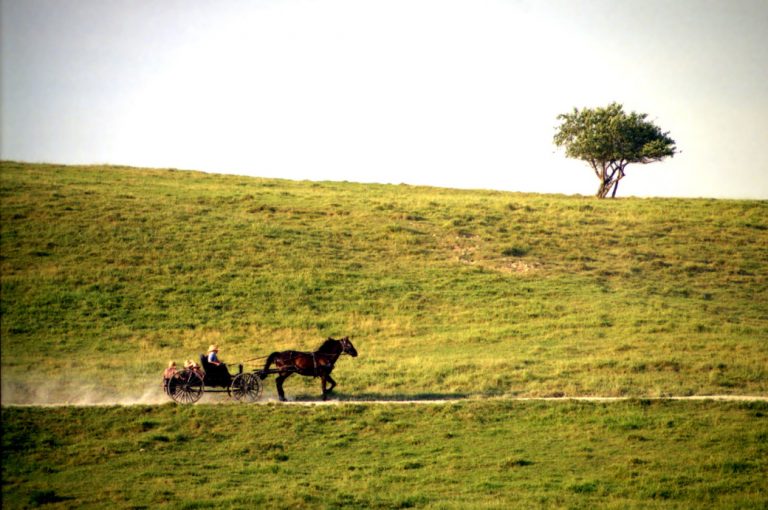Who Are The “Michigan Circle” Amish?
From time to time, Amish America features published articles from the Journal of Plain Anabaptist Communities (JPAC). This one was published in Volume 3, No. 1 (2022) issue of JPAC, written by Edsel Burdge, who is a research associate with the Young Center for Anabaptist and Pietist Studies at Elizabethtown College in Elizabethtown, Pennsylvania.
Edsel devotes a great deal of time to keeping track of settlement additions and extinctions, which is updated once each year (see the 2023 list here). His JPAC article is titled “The Michigan Amish Fellowship: A Case Study for Defining an Amish Affiliation”. Here are excerpts from Edsel’s article, which will give readers a greater appreciation of the diversity within Amish society. – Joseph Donnermeyer
“The Michigan Amish Fellowship (also known as the Michigan Circle) is a network of thirty-three settlements in Michigan, Maine, Missouri, Kentucky, Montana, and Wyoming that are formally affiliated with one another. (See Figures 1 and 2 in Appendix.) As such, they provide one model for defining an Amish affiliation. The idea of an affiliation is a contested subject. Kraybill, Johnson-Weiner, and Nolt in their landmark study, The Amish, defined an affiliation as “a cluster of two or more districts with…shared history. Affiliated congregations share similar Ordnungs, which specify distinctive lifestyles and visible symbols that set them apart from other affiliations.” (p. 138).
“The authors of The Amish observe that migration history, ethnicity, distinctive Ordnung practices, local conditions, and internal divisions can contribute to the formation or evolution of an affiliation. They also note that fellowship relationships in which ministers of various districts or settlements collaborate with one another are an important marker of an affiliation. Using these criteria, and building on the work of Stephen Scott, The Amish lists forty distinct Amish affiliations.”
“The Michigan Amish Fellowship has its roots in a movement that Stephen E. Scott has described as Amish Reformist. This movement originated in the Aylmer, Ontario, Amish settlement, which sponsors Pathway Publishers. Through its magazines, Family Life and Young Companions, Pathway has promoted a spirituality that maintains an intrinsic connection between inward renovation and the life lived both individually and corporately. This spirituality looks to its Anabaptist and Amish past for inspiration and guidance. Specifically, it has weighed in against tobacco use, impure courtship practices, and the more notorious wild Rumspringa activities in some of the larger Amish settlements.”

“The influence of Pathway has given rise to grassroots efforts by parents in some of the older and larger settlements like Lancaster County, Holmes County, and Elkhart-LaGrange to organized parent-sponsored youth groups that promote a reformist agenda. The reformist impulse has also been behind the establishment of new settlements where settlers aspire to organize a community along reformist principles. Another characteristic of the reformist mindset is an openness to seekers from non-Amish backgrounds. The seeds of the Michigan Amish Fellowship originated in a reformist settlement in Mio, in northern Michigan.”
“In 1983, Mio had grown to the point that the settlement divided into two districts. Up to this point, Mio was following a pattern similar to many other reformist-minded settlements. That pattern was significantly refined when Mio decided to start a daughter settlement in Evart, Michigan, in 1989. The Evart settlement appears to be the brainchild of Omar Miller, a minister from Charlotte, Michigan, who moved to Mio in 1982. Miller was later ordained bishop at Evart.”
“He has written, ‘The goal and vision of the church at Evart was to establish the Anabaptist vision of a scriptural church promoting true spirituality, obedience to God’s Word, and being a living witness to those around us. The church also has the vision of maintaining a Biblical view of evangelizing by starting other church communities rather than dividing the districts and growing into a large community.’ (Miller, Michigan Amish Directory, 258) There are three key ideas in Miller’s statement: “true spirituality,” “scriptural church,” and “living witness.”

“For the Michigan Amish Fellowship, “true spirituality” originates in the new birth, an inner transformation that results in obedience to God’s Word…. What distinguishes the Michigan Amish Fellowship from some other reformist-minded Amish is the mechanism by which they discern whether or not their members have the new birth. The Michigan Fellowship expects its members to articulate how they understand both the new birth and the ongoing experience of inner transformation. The Fellowship will not baptize youth or receive members from other Amish communities unless they can do so.”
“The Michigan Amish Fellowship understands a “scriptural church” to be one that operates as a brotherhood. As the Marion bishop said, ‘Whatever we do, we do as church.’ For example, when there is a school meeting, the expectation is that everyone will attend, not just the parents of the students. Also, discrete youth groups are downplayed. When a singing is planned, it is for the whole church, not just the youth.”

“The Michigan Fellowship believes that the most important vehicle for a “living witness” is a well-functioning brotherhood that demonstrates to its immediate neighbors what it means to love one another. Their hope is that such a witness will attract seekers. Of course, as with any Amish group, there are significant cultural barriers for those from non-Amish backgrounds to join an Amish church. One of the primary barriers is linguistic. The Michigan Fellowship attempts to bridge this barrier by conducting its Sunday schools in English and by providing non-Pennsylvania Dutch speakers with translators for church meetings. However, the number of members from non-Plain backgrounds is very small.”
Above and below are maps showing Michigan Circle settlements in both the state of Michigan, and states beyond Michigan. Since publication of this article and the maps, several changes have occurred. Both Hersey, Michigan and Brownsville, Kentucky have disbanded, and Caneyville, Kentucky have adopted cars. Most families from Brownsville moved to various Michigan Circle communities in Maine.

The Journal of Plain Anabaptist Communities is the premier journal for articles about the Amish, Mennonites, Brethren and other Plain Anabaptist communities. It is published twice each year and can be accessed at plainanabaptistjournal.org. While there, register for JPAC by clicking on the link in the upper right-hand corner. Registration is simple and can be completed in only a few minutes.






Stopping Car\Buggy Crashes
I am buying a few of solar warning lights for my Amish friends with Horse drawn Buggies. Not all Amish can use Solar, I hope my group does.
Job Offer
My cousin owns a vetrinary clinic in DeWitt just North of Lansing. I am attempting to find her an Amish teenager or older that could find transportation to be able to get to work everyday and also get home. A desire to work with animals and possibly be interested in becoming a veterinarian would be a plus.
Interested individuals can contact me
By calling, 907-500-2523
Thank You,
Roger Everett